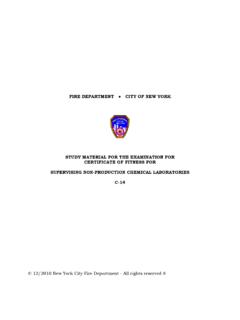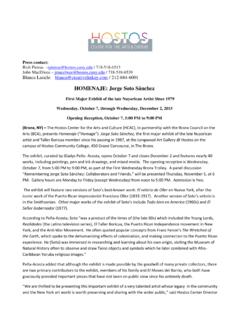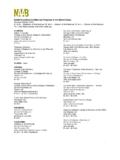Transcription of III. The History of Open Admissions and ... - City of New York
1 6 III. The History of open Admissions and Remedial Education at theCity university of New YorkCUNY s statutory mission has remained essentially unchanged since the Free Academy wasestablished in 1847. According to section 6201 of the New york State Education Law, cuny is an independent system of higher education committed to academic excellence andto the provision of equal access and opportunity for students, faculty and staff from all ethnicand racial groups and from both sexes. Access and excellence are cuny s historic over the past 30 years, the access portion of the mission has overwhelmed the university ,at the expense of excellence. This Part traces the History of that A, History of open Admissions and Remediation in the , shows that since atleast the late 1800s, this country s higher education sector has struggled over whether four-yearcolleges should provide postsecondary B, Educational Opportunity and Admissions Policies at cuny (1847-1968), explains that from 1847 when the first of the colleges that make up cuny was founded until the implementation of open Admissions in 1970, only those students with certain academiccredentials could be admitted to cuny undergraduate degree programs.
2 Competitive testscores (from 1847), a college preparatory or Regents diploma (from 1882), and a minimumhigh school average (from 1924) were required, at both the community and senior C, The Birth of open Admissions at cuny (1965-1970), describes how increasesin the availability of government aid for underprepared students, coupled with communitydemands for increased minority representation, led cuny to abandon its insistence onobjective standards of college readiness and to implement a policy of access for all high schoolgraduates. This decision was made in late 1969, and it was implemented less than twelvemonths later. In the fall of 1970, cuny s community colleges began to admit any student witha high school diploma Regents or not. The changes in senior college Admissions , while moresubtle, were more dramatic in effect: the senior colleges began to admit students with Regentsand non-Regents diplomas on equal terms; they began to admit students on the basis of classrank a relative rather than absolute measure; and they discontinued the use of standardizedtest scores for Section D, cuny s Solution to the Problem of Segregation (1969-1973), we learn thatthe cuny Trustees viewed racial and academic integration as virtually synonymous.
3 Thus, cuny s principal strategy for racial integration was to spread academically underpreparedstudents throughout the university s 17 colleges, and to create a sizeable identifiable group ofthe most severely underprepared students on each senior college E, The Early Years of open Admissions : cuny and the BOE (1970-1974), explains that cuny is unique among the nation s large open Admissions public universitysystems in that more than half of its students come from a single school system: the New YorkCity public schools. In the early years of open Admissions , cuny officials were shocked todiscover how poorly prepared many of the new students were. They viewed these students poor reading skills as a major indictment of the city s high schools, and they consideredreturning the responsibility for remediation to the public schools. Eventually, however, theydecided to focus on improving the articulation between BOE and cuny Section F, cuny Faces a Turning Point (1975-1976), we learn that, during a period offiscal crisis, cuny s Trustees twice voted to reestablish Admissions standards.
4 The first planwould have required applicants to demonstrate 8th grade competency in reading and math; thesecond would have required those community college students who did not have a minimumhigh school average, class rank, or General Equivalency Diploma ( GED )3 score to obtainremediation through a transitional program. Neither of these policies was ever 1976, cuny bowed to political pressures and began charging tuition, for the first time in itslong G, The Institutionalization of Remediation (1976-1990), identifies two trends thatfueled the institutionalization of large-scale postsecondary remediation at cuny : a decline inthe quality of the public schools (arguably a result of cuny s own open Admissions policy),and the decline in cuny enrollment that followed the imposition of tuition. By the late-1970s,the city s public schools had deteriorated to such a point that a significant number of graduateswith B averages were arriving at cuny with extensive remedial needs.
5 School officialsattributed declines in rigorous courses to the initiation of open Admissions at , cuny in response to declining enrollment lowered its Admissions standardsand sent counselors into the public schools to recruit students. During this period, and in theyears that followed, the Trustees and the administration struggled to establish system-widestandards for grading, academic progress, transfer, testing, and other issues raised by the influxof vast numbers of remedial H, The Gap Between Policy and Implementation (1993-1999), documents cuny sfailure to implement and enforce many of the transfer and testing policies that were establishedby the Trustees in 1976 and 1985. Some of those policies were not fully implemented until1998 more than twenty years after their recent years, cuny has enacted numerous policies aimed at ratcheting up I, Standards Revisited (1992-1999), describes cuny s new policy directions in theareas of college preparation, Admissions , testing, remediation, and graduation.
6 While some of 3 See footnote 239 for an explanation of the recent changes were based on a systematic analysis of what has worked in the past, othersseem more reactive and less carefully thought , Section J, Epilogue, reflects on three decades of policymaking in the areas ofadmissions and remediation. Before 1970, cuny provided what was, by all accounts, anexcellent education, but its standards of access while broader than most were clearlyunacceptable in post-civil-rights-movement America. Over the last 29 years, cuny hasprovided broad access, but in the process, its seventeen colleges have become academicallyhomogenized. In the 1990s, the university has begun to try to restore the balance between thetwo aspects of its historic mission. A return to bachelor s admission standards that emphasizeRegents courses, high school grades, and standardized testing is one hopeful sign of this new History of open Admissions and Remedial Education in the Admissions in this country dates back to the 19th century, when Congress passed theMorrill Act to assist states in financing higher education institutions, known as land-grantcolleges, to teach agriculture and mechanical arts.
7 These colleges were typically open to allstate residents who had completed an academic course of study in high , open Admissions is associated more closely with two-year community colleges. Suchinstitutions date back to the early 20th century, when state policymakers, recognizing thatgeography and cost were barriers to attendance at senior colleges, established junior colleges toprovide lower-division course work in more accessible locations and at a lower AfterWorld War II, in response to the increase in demand for access to public higher educationfueled by the Bill, the mission of junior colleges was expanded to include the promotion oflifelong learning. In addition to offering the first two years of the four-year degree, they threwopen their doors to students who wanted to pursue vocational, college preparation, and adultand continuing education remediation has a somewhat longer History in this country than open Admissions ,if one considers Harvard College s provision of Latin and Greek tutors to its underpreparedstudents in the 1600s to be a form of Table 1 shows that, since at least the late 4 Albert L.
8 Lorenzo, The Mission and Functions of the Community College: An Overview, in A Handbook onthe Community College in America, ed. George A. Baker, III. (Westport: Greenwood Press, 1993), Ibid., James L. Ratcliff, Seven Streams in the Historical Development of the Modern American Community College, in A Handbook on the Community College in America, ed. George A. Baker, III. (Westport: Greenwood Press, 1993), Milton G. Spann and Suella McCrimmon, Remedial/Developmental Education: Past, Present, and Future, inA Handbook on the Community College in America, ed. George A. Baker, III. (Westport: Greenwood Press, 1993), , the higher education sector has struggled over where to locate postsecondaryremediation and how to explain the need for 1. History of Remediation in the , 1800s - PresentHistorical ContextLocus of RemediationExplanations ofPoor Academic Performance19thcentury -early 20thcenturyPrimary andsecondary educationwere in uterothroughout the educationwas not enforceduntil the early early as the mid-1800s,universities were calling for an endto the admission of students with defective preparation.
9 Betweenthe Civil War and WWI,remediation was widespread inAmerican 1894 through the 1920s, itwas widely believed that poorstudy habits were theunderlying cause of pooracademic -WWIIHigh schoolpreparationimproved. A newgeneration of two-year colleges four-year institutionsstopped providing colleges absorbed mostof the remedial the 1930s and 40s, poorreading and study skills werebelieved to be the causes ofpoor academic a result of the , colleges anduniversities wereflooded colleges began testingapplicants to separate underachievers from low-ability students and tried to admitonly the more promisingunderprepared students. Many ofthose who were rejected the so-called low-ability students enrolled instead in communitycolleges and technical professionals beganto cite environmental andsocioeconomic factors as theprimary causes of pooracademic performance, and compensatory replaced remedial as the term of choiceto describe the extra educationthese students drove upfour-year bulk of remediation shifted totwo-year -1970sIncreasing numbersof underpreparedstudents weregraduating from highschool.
10 The HigherEducation Act,passed in 1965,expanded access foreducationally and four-year collegesexpanded access and beganoffering some credit for remedialwork. Remediation became a majorfunction of community the 1970s, access continued toexpand, and remediation becameinstitutionalized at thepostsecondary and educationprofessionals continued tobelieve that socioeconomicfactors were the mainimpediment to academicachievement until the early1970s, when multiple factorssuch as cultural and individualdifferences and differentlearning styles were added tothe list of causes. Developmental education, focusing on academic potentialrather than deficit, became thepreferred -1990sHigher educationresources havegrown tighter. ThePolicymakers and highereducation institutions have onceagain begun scrutinizing the11number of studentsrequiringpostsecondaryremediatio n hasincreased Many states are movingtowards strengthening K-12preparation, raising admissionstandards for bachelor s degreeprograms, and encouraging arange of providers to offerremedial programs, includingcommunity colleges and privatefor-profit and : Baker; Boylan; Maxwell; Ignash; McMillan et al.

















